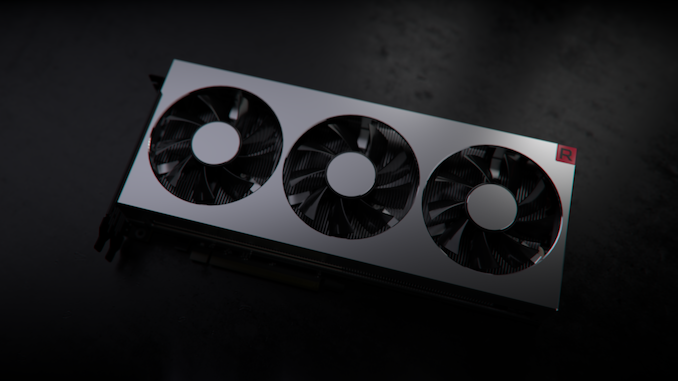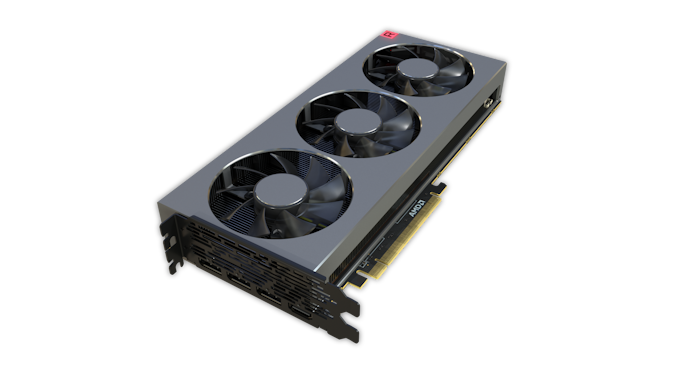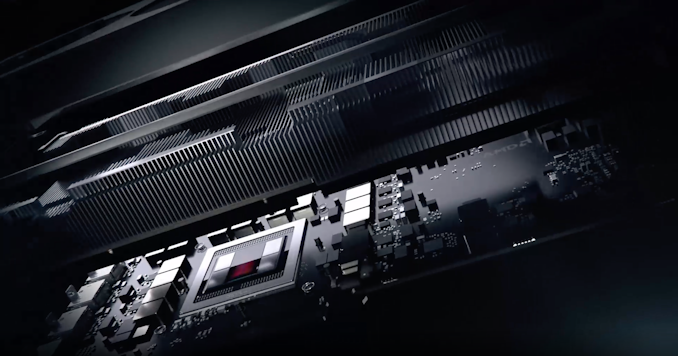The AMD Radeon VII Review: An Unexpected Shot At The High-End
by Nate Oh on February 7, 2019 9:00 AM ESTMeet The Radeon VII
First things first is the design and build, and for the AMD Radeon VII, we've already noticed the biggest change: an open air cooler. Keeping the sleek brushed metal look of the previous RX Vega 64 Limited Edition and Liquid variants, they've forgone the blower for a triple axial fan setup, the standard custom AIB configuration for high-end cards.
While NVIDIA's GeForce RTX series went this way with open-air dual-fan coolers, AMD is no stranger to changing things up themselves. Aside from the RX Vega 64 Liquid, the R9 Fury X's AIO CLC was also quite impressive for a reference design. But as we mentioned with the Founders Edition cards, moving away from blowers for open-air means adopting a cooling configuration that can no longer guarantee complete self-cooling. That is, cooling effectiveness won't be independent of chassis airflow, or lack thereof. This is usually an issue for large OEMs that configure machines assuming blower-style cards, but this is less the case for the highest-end cards, which for pre-builts tend to come from boutique system integrators.
The move to open-air does benefit higher TDP, and at 300W TBP the Radeon VII is indeed one for higher power consumption. While 5W more than the RX Vega 64, there's presumably more localized heat with two more HBM2 stacks, plus the fact that the same amount of power is being consumed but on a smaller die area. And at 300W TBP, this would mean that all power-savings from the smaller process were re-invested into performance. If higher clockspeeds are where the Radeon VII is bringing the majority of its speedup over RX Vega 64, then there would be little alternative to abandoning the blower.
Returning to the Radeon VII build, then, the card naturally has dual 8-pin PCIe connectors, but lacks the BIOS switch of the RX Vega cards that toggled a lower-power BIOS. And with the customary LEDs, the 'Radeon' on the side lights up, as does the 'R' cube in the corner.
In terms of display outputs, there are no surprises here with 3x DisplayPort and 1x HDMI.
A few teardowns of the card elsewhere revealed a vapor chamber configuration with a thermal pad for the TIM, rather than the usual paste. While lower-performing in terms of heat transfer, we know that the RX Vega cards ended up having molded and unmolded package variants, requiring specific instructions to manufacturers on the matter. So this might be a way to head off potential ASIC height difference issues.














289 Comments
View All Comments
Icehawk - Thursday, February 7, 2019 - link
FFXV results sure look CPU limited to me - why aren't you running at least an 8700 @ 5ghz?Oxford Guy - Thursday, February 7, 2019 - link
They look like GameWorks or something to me but I can't see why anyone cares about FF anyway. I hurt my face smirking when I saw the footage from that benchmark. Those hairstyles and that car... and they're going fishing. It was so bad it was Ed Wood territory, only it takes itself seriously.luisfp - Thursday, February 7, 2019 - link
People don't forget that Vega GPUs have the memory beside the GPU core, therefore making it more hot that normal GPUs out there. That has a lot to do with how hot it seems to be, the temperature tends to raise more due to memory temps in same area.just4U - Thursday, February 7, 2019 - link
True enough but owners of the 56/64 have found many work arounds to such things as the cards have not needed as much power as they push out. My cards (56s) use 220W of power per card They never go over 65c in any situation and usually sit in the high 50s to low 60s. with their undervolts.luisfp - Thursday, February 7, 2019 - link
I believe that Vega GPUs have the memory beside the GPU core, therefore making it more hot that normal GPUs out there. That might have a lot to do with how hot it seems to be, the temperature tends to raise more due to memory temps in same area.just4U - Thursday, February 7, 2019 - link
Better than a 64 in all situations and comparable to a 1080ti in all situations with only 5-6% performance hits against the 2080 which is costing 50-100 more here in Canada (according to pre-order sales) Yep, Im sold.ballsystemlord - Thursday, February 7, 2019 - link
Your favorite spelling/grammar guy is here. (AT Audience: Boo!)"Faced with a less hostile pricing environment than many were first expecting, AMD has decided to bring Vega 20 to consumers after all, duel with NVIDIA one of these higher price points."
Missing words (and & at):
"Faced with a less hostile pricing environment than many were first expecting, AMD has decided to bring Vega 20 to consumers after all, and duel with NVIDIA at one of these higher price points."
"Which is to say that there's have been no further developments as far as AMD's primitive shaders are concerned."
Verb tense problem:
"Which is to say that there's been no further developments as far as AMD's primitive shaders are concerned."
Thanks for the review!
I read the whole thing.
The F@H results for Vega are higher than I predicted (Which is a good thing!).
Ryan Smith - Thursday, February 7, 2019 - link
"Your favorite spelling/grammar guy is here. (AT Audience: Boo!)"You're always welcome here. Pull up a chair!
ballsystemlord - Friday, February 8, 2019 - link
I was joking. Some site content creators call people like me "The spelling and grammar trolls".I can never really be certain, so I try to be a little funny in hopes that no body will take my corrections as "troll" actions.
I don't know how you guys feel, but you've always taken mine and others corrections into consideration.
Ryan Smith - Saturday, February 9, 2019 - link
Our flaws and errors are our own doing. When pointed out, it's our job as journalists to correct them. So as long as people are being polite about it, we appreciate the feedback.